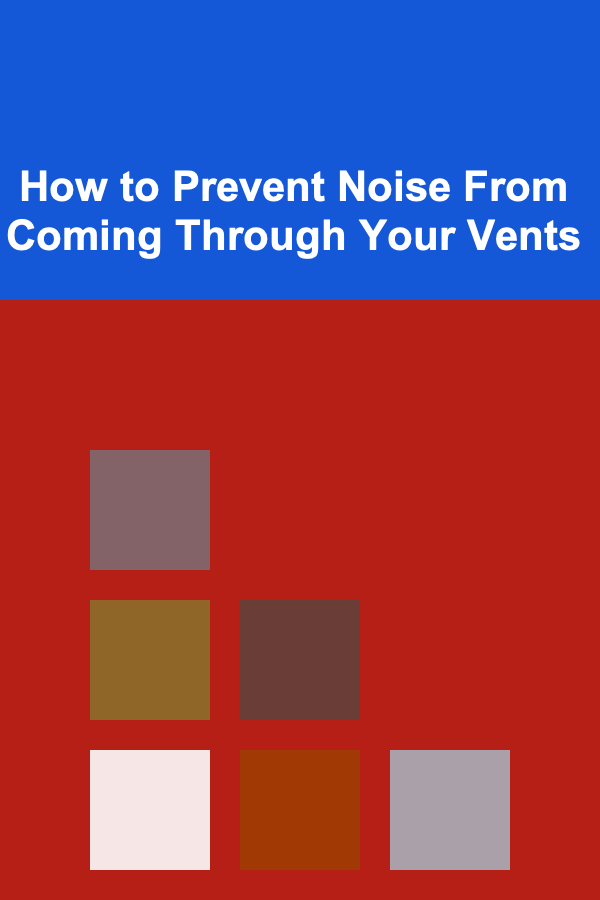
How to Prevent Noise From Coming Through Your Vents
ebook include PDF & Audio bundle (Micro Guide)
$12.99$6.99
Limited Time Offer! Order within the next:

Noise infiltration through vents is a common issue that can disrupt the peace and comfort of your home or workplace. Whether it's the hum of an HVAC system, voices from the neighboring rooms, or street noise carried through your air ducts, noise traveling through vents can be incredibly frustrating. It's not only a matter of discomfort, but persistent noise can also affect sleep quality, productivity, and general well-being.
This comprehensive guide will delve into the causes of noise in your vents and explore practical solutions to prevent or reduce it. From simple DIY approaches to more advanced soundproofing techniques, you'll learn how to safeguard your space from the intrusion of unwanted noise through your ventilation system.
Understanding the Causes of Vent Noise
Before discussing the various solutions to prevent noise from coming through your vents, it's essential to understand the causes. Noise can enter your space via vents due to several reasons, ranging from poor system design to environmental factors outside your home. Let's break down the primary sources of vent noise:
1. Airborne Sound Transmission
Airborne sound, such as voices, music, or the hum of machinery, can travel through the ventilation system if it's not adequately soundproofed. This is particularly noticeable in multi-story buildings or apartments, where sounds from neighboring units can easily pass through shared air ducts.
2. Impact Noise
Impact noise, such as footsteps, furniture movement, or even the slamming of doors, can be transmitted through the building structure and into your air ducts. The ducts act as conduits for vibrations, amplifying these noises and making them more apparent.
3. HVAC System Noise
The most common source of vent noise is the HVAC (Heating, Ventilation, and Air Conditioning) system itself. While HVAC units are essential for regulating air temperature and quality, they can be noisy if the system isn't maintained properly. Air moving through the ducts, vibrations from the fan or motor, and even the sound of the air conditioning compressor can contribute to unwanted noise.
4. External Noise
In some cases, external noise, such as street traffic, construction work, or lawn equipment, can find its way into your home via the vents. This is especially true if the vents or ducts are not well-sealed or are poorly insulated.
5. System Design and Installation Issues
Inadequate duct design or improper installation can lead to excessive noise. For example, ducts that are too small or poorly sealed can cause air to flow erratically, creating whistling or buzzing sounds. Similarly, if the ducts are not well-secured to the walls or ceilings, they can vibrate and amplify the sounds of airflow.
Methods for Preventing Noise from Coming Through Vents
While completely eliminating noise from your vents may not always be possible, there are several methods and strategies to significantly reduce it. These solutions range from simple DIY fixes to more complex professional interventions, depending on the severity of the problem.
1. Install Soundproofing or Acoustic Insulation in Ducts
One of the most effective ways to block noise from coming through vents is to add soundproofing insulation to the ducts themselves. This method helps absorb sound before it has a chance to travel through the air ducts and into your living space.
Types of Soundproofing Insulation:
- Fiberglass Insulation: This is the most common type of insulation used for soundproofing ducts. It's made from tiny glass fibers that trap sound waves and prevent them from passing through. Fiberglass insulation can be wrapped around the ducts or placed inside the ductwork itself.
- Mineral Wool Insulation: Mineral wool is denser than fiberglass, making it an even more effective soundproofing material. It also offers the added benefit of being fire-resistant.
- Acoustic Foam: Acoustic foam is another option for soundproofing. It's designed to absorb sound and can be used to line the inside of air ducts or placed around vents to reduce noise.
Installation:
- To insulate your ducts, you can either hire a professional or attempt a DIY installation. Wrap the insulation material around the ducts and seal it with tape or fasteners. If the ducts are inside walls or ceilings, you may need to remove some drywall to access them.
2. Seal Gaps and Leaks in the Ducts
Even small gaps in your ducts can allow noise to travel freely through your ventilation system. If your ducts have visible holes or leaks, air can escape, creating noise, and allowing sound to pass from one room to another.
How to Seal Ducts:
- Duct Tape: Use high-quality duct tape to seal small leaks around the ducts.
- Mastic Sealant: Mastic is a thick, paste-like sealant that can be applied to seams and joints to create a tight seal.
- Foam Gaskets: For larger gaps, foam gaskets can be applied to prevent noise from escaping.
Sealing leaks and gaps not only prevents noise but also helps improve energy efficiency, reducing heating and cooling costs.
3. Use Soundproof Vents and Grilles
Standard vents and grilles allow noise to travel freely through your air ducts. To reduce sound transmission, consider replacing your existing vents with specialized soundproof vents.
Types of Soundproof Vents:
- Acoustic Vents: These vents are specifically designed to minimize the transmission of sound. They often feature sound-damping materials and unique designs that absorb sound before it escapes into the room.
- Louvered Vents: Louvered vents are designed with angled slats, which can help block noise from entering the space. The design reduces the amount of air that passes through and dampens sound.
Installing soundproof vents is a relatively simple fix that can be done yourself or by a professional. The added benefit of soundproof vents is that they are often more efficient at controlling airflow and reducing drafts.
4. Install a Vent Noise Filter or Muffler
A vent noise filter or muffler is a device that fits into the air duct to reduce noise from both the airflow and external sounds coming through the system. These devices are similar to the mufflers in a car's exhaust system---they absorb sound and reduce the intensity of the noise.
How Vent Mufflers Work:
- Vent mufflers typically consist of sound-absorbing materials like fiberglass or mineral wool and are designed to fit inside the duct. They work by dampening the sound as the air flows through the ducts.
- These mufflers can be installed at the point where the ducts connect to the vents, or they can be placed directly within the ducts themselves to reduce the transmission of noise.
5. Upgrade Your HVAC System
If the noise coming from your vents is primarily due to the HVAC system itself (such as fan noise or motor vibrations), upgrading or replacing certain components of the system can help reduce sound.
Upgrading HVAC Components:
- Install a Quieter Fan: If your HVAC fan is too noisy, replacing it with a quieter model can make a significant difference.
- Upgrade to a Variable-Speed Fan: Variable-speed fans are quieter and more energy-efficient than traditional fans. They also help to reduce the overall noise level by adjusting to the specific heating or cooling needs of the space.
- Soundproof the HVAC Unit: If your HVAC unit is located in a mechanical room, you can install soundproof panels or acoustic foam around the unit to dampen noise.
- Check for Proper Maintenance: Sometimes, excessive HVAC noise is caused by mechanical problems or poor maintenance. Ensure your system is properly maintained and that parts like motors, fans, and belts are in good condition.
6. Create an Air Barrier in the Room
While modifying your ducts is essential, you can also reduce vent noise by creating an air barrier within the room. This involves adding materials to the ceiling or walls that help absorb sound before it enters your space.
Methods for Creating an Air Barrier:
- Acoustic Panels: Install acoustic foam panels on the walls or ceiling around the vent areas. These panels absorb sound and prevent it from traveling through the walls.
- Soundproofing Curtains: Heavy, dense curtains can block out noise that enters through the vents, especially in bedrooms or offices where quiet is essential.
- Weatherstripping: Apply weatherstripping around doorframes and windows to prevent noise from entering your room through gaps and cracks.
7. Consider Acoustic Duct Lining
For more extensive soundproofing, consider installing acoustic duct lining. This involves lining the interior of the ducts with a specialized material that absorbs sound. Acoustic duct lining is particularly effective at reducing high-frequency noise, such as the hum of an air conditioning unit or fan.
Types of Acoustic Duct Lining:
- Fiberglass Duct Lining: Fiberglass is one of the most common materials used for duct lining. It's highly effective at absorbing sound and is available in various thicknesses.
- Foam Duct Lining: Acoustic foam can also be used for duct lining. It's effective at reducing high-frequency noise and is easier to install than fiberglass.
8. Use White Noise Machines
If noise from the vents is still problematic despite all efforts, you can mask the sound with white noise machines. These machines generate a consistent sound that helps drown out unwanted noise, creating a more peaceful environment.
How White Noise Machines Work:
- White noise machines produce a steady sound that masks environmental noises. The noise emitted by these devices can help cover up the sounds coming from your vents, making them less noticeable and less intrusive.
Conclusion
Preventing noise from coming through your vents requires a combination of techniques, from sealing gaps and upgrading your HVAC system to installing soundproofing materials. By taking a multi-faceted approach to vent noise reduction, you can create a quieter, more comfortable environment in your home or office. Whether you're looking to tackle minor issues with simple fixes or invest in more extensive solutions, there are plenty of options available to address vent noise effectively.
Reading More From Our Other Websites
- [Organization Tip 101] How to Incorporate Storage Solutions into Your Furniture
- [Home Budget 101] How to Budget for a Home Renovation Project and Stay on Track
- [Personal Investment 101] How to Create an AI-Powered App for Passive Income
- [Needle Felting Tip 101] Starting Your Needle Felting Business: A Step-by-Step Guide for Creatives
- [Stamp Making Tip 101] Linoleum Love: Beginner's Guide to Creating Your First Custom Stamp
- [Home Cleaning 101] How to Sanitize Your Home Without Using Harsh Chemicals
- [Metal Stamping Tip 101] Automation & Precision: The Role of AI‑Driven Metal Stamping in Autonomous Car Design
- [Organization Tip 101] How to Organize Books and Magazines Related to Your Hobby
- [Home Party Planning 101] How to Create an Amazing Dessert Table for Your Home Party
- [Skydiving Tip 101] Skydiving Gear Brands Every Aerial Adventurer Should Know

How to Make a Budget That Works for Your Family's Needs
Read More
How to Repair Common Utensil Issues for Longevity
Read More
How to Utilize Old Furniture for Craft Supply Storage
Read More
10 Tips for Mastering Customer Service Software
Read More
Time Blocking for Moms: A Practical Guide
Read More
How to Etch Glass with Household Items
Read MoreOther Products

How to Make a Budget That Works for Your Family's Needs
Read More
How to Repair Common Utensil Issues for Longevity
Read More
How to Utilize Old Furniture for Craft Supply Storage
Read More
10 Tips for Mastering Customer Service Software
Read More
Time Blocking for Moms: A Practical Guide
Read More